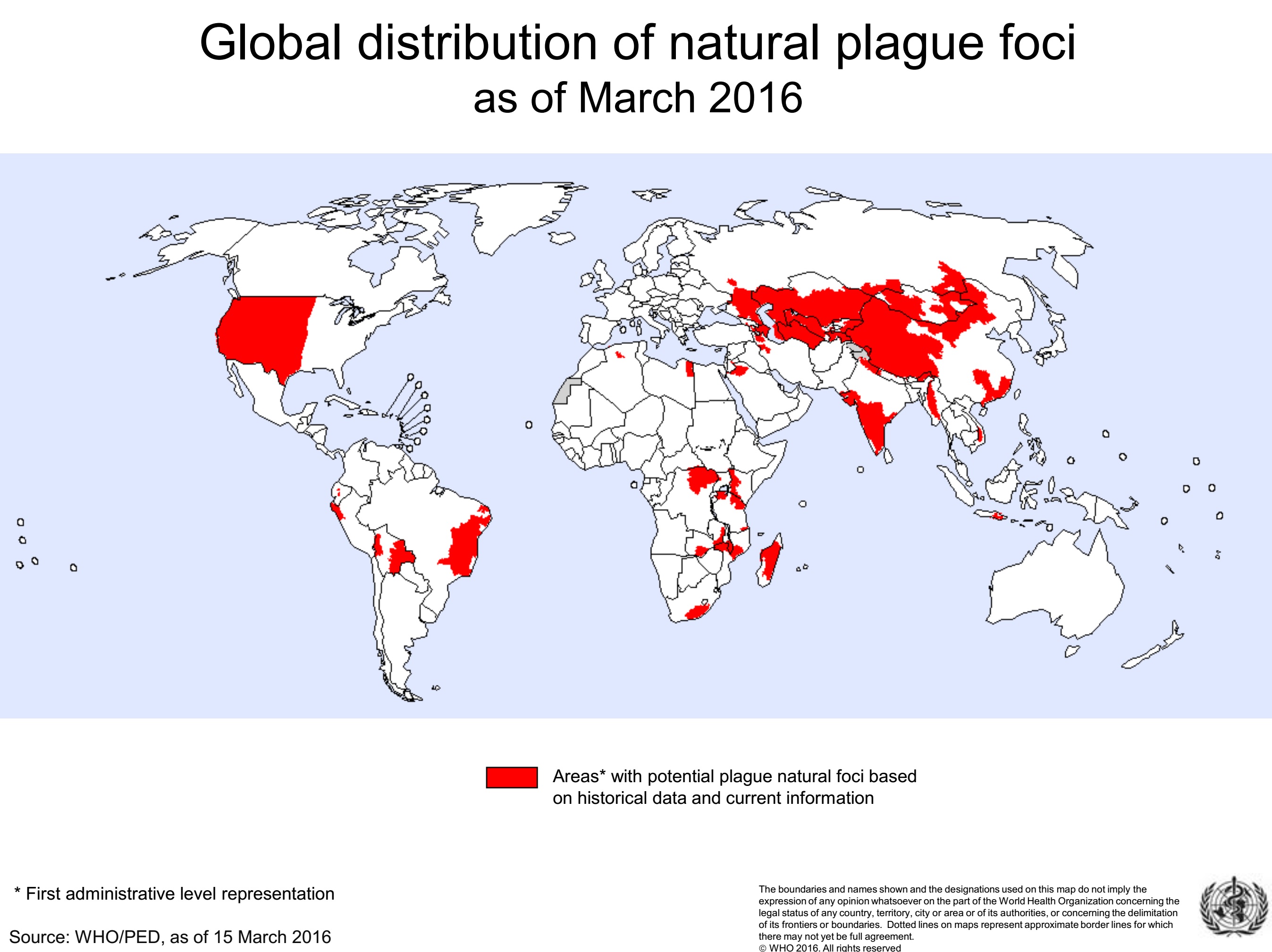Yersinia pestis infection epidemiology and demographics
|
Yersinia pestis infection Microchapters |
|
Differentiating Yersinia Pestis Infection from other Diseases |
|---|
|
Diagnosis |
|
Treatment |
|
Case Studies |
|
Yersinia pestis infection epidemiology and demographics On the Web |
|
American Roentgen Ray Society Images of Yersinia pestis infection epidemiology and demographics |
|
FDA on Yersinia pestis infection epidemiology and demographics |
|
CDC on Yersinia pestis infection epidemiology and demographics |
|
Yersinia pestis infection epidemiology and demographics in the news |
|
Blogs on Yersinia pestis infection epidemiology and demographics |
|
Risk calculators and risk factors for Yersinia pestis infection epidemiology and demographics |
Editor-In-Chief: C. Michael Gibson, M.S., M.D. [1]; Associate Editor(s)-in-Chief: Serge Korjian, Yazan Daaboul, Aravind Reddy Kothagadi M.B.B.S[2]
Overview
Given its ability to cause serious pandemics, plague is one of the three diseases subject to the International Health Regulations, the other two being yellow fever and cholera. From 1954 to 1997, plague affected 38 countries, with 80 613 cases and 6587 deaths.[1] Between 2004 and 2009, the WHO reported that the number of cases of plague worldwide was 12,503, with 843 deaths, for a case-fatality rate of 6.7%.[2]
Epidemiology and Demographics
Incidence
- From 1954 to 1997, plague affected 38 countries, with 80 613 cases.[1]
Age
- Patients of all ages are susceptible to disease; however, cases in the last few decades have been more common in children.[3]
Gender
- Patients of both sexes are susceptible to disease.[3]
Mortality
- Known as the black death, plague pandemics have caused significant casualties in the last 2 millennia. The first certain pandemic recorded in the sixth century AD spread across Asia, Africa and Europe claiming approximately 100,000,000 lives. The fourteenth century witnessed the second pandemic, with no less than 50,000,000 casualties. The third pandemic came in the late nineteenth century mostly affecting India with 13,000,000 recorded deaths.[4]
- From 1954 to 1997, plague affected 38 countries, with 6587 deaths.[1]
Geographic Distribution
- Yersinia pestis in found in animal reservoirs, especially in rodents which are often responsible for the rapid spread of the disease. Natural foci of plague are found all over the world, particularly in tropical and sub-tropical latitudes and in warm regions of the temperate latitudes.
- All continents are known to harbor natural plague foci except Australia.
- It is important to note that natural foci of plague shift in response to changes in climate, landscape, and rodent population migration.[1]
| Chronology of Yersinia pestis infection Outbreaks("WHO | Plague".) | |||||
| Date | Region Affected | Suspected, Probable & Confirmed Cases | Deaths | Details | |
| 15 October 2017 | Seychelles - Suspected Plague (Ex- Madagascar) | 1 | 0 |
| |
| 2 October 2017 | Madagascar | 73 | 17 |
| |
| 29 September 2017 | Madagascar | 51 | 12 |
| |
| 9 January 2017 | Madagascar | 62 cases (6 confirmed, 5 probable, 51 suspected) | 26 (case fatality rate of 42%) |
| |
| 6 September 2015 | Madagascar | 14 | 10 |
| |
| 21 November 2014 | Madagascar | 119 | 40 |
| |
| 10 August 2010 | Peru | 17 | - |
| |
| 11 August 2009 | China | 12 | 3 |
| |
| 7 November 2006 | Democratic Republic of the Congo | 1174 | 50 |
| |
| 13 October 2006 | Democratic Republic of the Congo | 626 | 42 |
| |
| 14 June 2006 | Democratic Republic of the Congo | 100 | 19 |
| |
| 15 March 2005 | Plague in the Democratic Republic of the Congo - update 4 | 130 | 57 |
| |
| 9 March 2005 | Plague in the Democratic Republic of the Congo - update 3 | 114 cases (110 suspect cases, 4 probable cases) | 54 |
| |
| 4 March 2005 | Plague in the Democratic Republic of the Congo - update 2 | 57 cases (54 suspect cases, 3 probable cases) | 16 |
| |
| 1 March 2005 | Plague in the Democratic Republic of the Congo - update | 4 probable cases and 4 suspect cases | 1 |
| |
| 18 February 2005 | Plague in the Democratic Republic of the Congo | - | 61 |
| |
| 10 July 2003 | Plague in Algeria - Update 2 | 10 laboratory confirmed cases and 1 probable case | - |
| |
| 3 July 2003 | Plague in Algeria - Update | 10 cases of which 8 have been laboratory confirmed | - |
| |
| 24 June 2003 | Plague in Algeria | 10 cases, 8 cases of bubonic plague and 2 of septicemic plague | one fatal case reported |
| |
| 5 June 2002 | 2002 - Plague in Malawi | 71 | - |
| |
| 20 February 2002 | 2002 - Plague in India | 16 cases of pneumonic plague | 4 deaths in Hat Koti village |
| |
| 26 March 2001 | 2001 - Plague in Zambia | 23 hospitalized cases | 3 deaths in Petauke district, Eastern Province |
| |
Shown below is a picture depicting the global distribution of natural plague foci as of March 2016

References
- ↑ 1.0 1.1 1.2 1.3 World Health Organization (1999). "Plague Manual: Epidemiology, Distribution, Surveillance and Control". WHO/CDS/CSR/EDC.
- ↑ 2.0 2.1 2.2 "Human plague: review of regional morbidity and mortality, 2004-2009". Wkly Epidemiol Rec. 85 (6): 40–5. 2009. PMID 20151494.
- ↑ 3.0 3.1 Butler T (2009). "Plague into the 21st century". Clin Infect Dis. 49 (5): 736–42. doi:10.1086/604718. PMID 19606935.
- ↑ Cohn SK (2008). "Epidemiology of the Black Death and successive waves of plague". Med Hist Suppl (27): 74–100. PMC 2630035. PMID 18575083.